Charting Dynamic Areas in the Mackenzie River with RADARSAT-2, Simulated RADARSAT Constellation Mission and Optical Remote Sensing Data
Abstract
1. Introduction
2. Materials and Methods
2.1. Study Site
2.2. Water Level
2.3. Satellite Imagery
2.3.1. RADARSAT-2
2.3.2. Optical Data
3. Methodology
3.1. SAR Polarization Selection
3.2. SAR Data Preprocessing
3.3. Optical Data Preprocessing
3.4. Image Segmentation and Classification
3.5. Rate of Change
4. Results
4.1. Selection of Polarization
4.2. Shoreline Extraction
4.3. Rate of Change
5. Discussion
6. Conclusions
Author Contributions
Funding
Acknowledgments
Conflicts of Interest
References
- Riopel, S.; Couture, R.; Tewari, K. Mapping susceptibility to landslides in a permafrost environment: Case study in the Mackenzie Valley, Northwest Territories. In Proceedings of the GeoTech Event 2006, Ottawa, ON, Canada, 18–21 June 2006. [Google Scholar]
- Carson, M.A.; Jasper, J.N.; Conley, F.M. Magnitude and sources of sediment input to the Mackenzie Delta, Northwest Territories, 1974–1994. Arctic 1998, 51, 116–124. [Google Scholar] [CrossRef]
- Chénier, R.; Ahola, R.; Sagram, M.; Faucher, M.-A.; Shelat, Y. Consideration of Level of Confidence within Multi-Approach Satellite-Derived Bathymetry. ISPRS Int. J. Geo Inf. 2019, 8, 48. [Google Scholar] [CrossRef]
- Marcus, W.A.; Fonstad, M.A. Optical remote mapping of rivers at sub-meter resolutions and watershed extents. Earth Surf. Process. Landf. 2008, 33, 4–28. [Google Scholar] [CrossRef]
- Bizzi, S.; Demarchi, L.; Grabowski, R.C.; Weissteiner, C.J.; Van de Bund, W. The use of remote sensing to characterise hydromorphological properties of European rivers. Aquat. Sci. 2016, 78, 57–70. [Google Scholar] [CrossRef]
- Neal, J.; Schumann, G.; Bates, P.; Buytaert, W.; Matgen, P.; Pappenberger, F. A data assimilation approach to discharge estimation from space. Hydrol. Process. 2009, 23, 3641–3649. [Google Scholar] [CrossRef]
- Rinaldi, M.; Surian, N.; Comiti, F.; Busettini, M. A method for the assessment and analysis of the hydromorphological condition of Italian streams: The Morphological Quality Index (MQI). Geomorphology 2013, 180, 96–108. [Google Scholar] [CrossRef]
- Spada, D.; Molinari, P.; Bertoldi, W.; Vitti, A.; Zolezzi, G. Multi-Temporal Image Analysis for Fluvial Morphological Characterization with Application to Albanian Rivers. ISPRS Int. J. Geo Inf. 2018, 7, 314. [Google Scholar] [CrossRef]
- Van der Sanden, J.J.; Drouin, H.; Bian, Y. Repeat Pass InSAR Observations of River and Lake Ice Cover: A Preliminary Evaluation of Information Content. In Proceedings of the 17th Workshop on River Ice, Edmonton, AB, Canada, 21–24 July 2013. [Google Scholar]
- Ullman, T.; Schmitt, A.; Jagdhuber, T. Two Component Decomposition of Dual Polarimetric HH/VV SAR Data: Case Study for the Tundra Environment of the Mackenzie Delta Region, Canada. Remote Sens. 2016, 8, 1027. [Google Scholar] [CrossRef]
- Normandin, C.; Frappart, F.; Lubac, B.; Bélanger, S.; Marieu, V.; Blarel, F.; Robinet, A.; Guiastrennec-Faugas, L. Quantification of surface water volume changes in the Mackenzie Delta using satellite multi-mission data. Hydrol. Earth Syst. Sci. 2018, 22, 1543–1561. [Google Scholar] [CrossRef]
- Chénier, R.; Hemmingway, C. Updating CHS Charts with Remote Sensing Data—A RADAR and Optical Approach. In Proceedings of the Canadian Hydrographic Conference 2014 (CHC2014), St. John’s, NL, Canada, 14–17 April 2014. [Google Scholar]
- Chénier, R.; Faucher, M.A.; Ahola, R.; Jiao, X.; Tardif, L. Remote Sensing Approach for Updating CHS Charts. In Proceedings of the Canadian Hydrographic Conference, Halifax, NS, Canada, 16–17 May 2016. [Google Scholar]
- Chénier, R.; Faucher, M.A.; Ahola, R. Satellite-derived bathymetry for improving Canadian Hydrographic Service charts. ISPRS Int. J. Geo-Inf. 2018, 7, 306. [Google Scholar] [CrossRef]
- Canada’s Next-Generation RADARSAT Satellite Constellation Successfully Launches to Space. Available online: https://www.canada.ca/en/space-agency/news/2019/06/canadas-next-generation-radarsat-satellite-constellation-successfully-launches-to-space.html (accessed on 17 June 2019).
- Charbonneau, F.; Brisco, B.; Raney, K.; McNairn, H.; Liu, C.; Vachon, P.; Shang, J.; De Abreu, R.; Champagne, C.; Merzouki, A.; et al. Compact polarimetry overview and applications assessment. Can. J. Remote Sens. 2010, 36, S298–S315. [Google Scholar] [CrossRef]
- Daboor, M.; Geldsetzer, T. Towards sea ice classification using simulated RADARSAT constellation mission compact polarimetric SAR imagery. Remote Sens. Environ. 2014, 140, 189–195. [Google Scholar] [CrossRef]
- Geldsetzer, T.; Arkettt, M.; Zagon, T.; Charbonneau, F.; Yackel, J.; Scharien, R. All-season compact-polarimetry C-band SAR observations of sea ice. Can. J. Remote Sens. 2015, 41, 485–504. [Google Scholar] [CrossRef]
- White, L.; Millard, K.; Banks, S.; Richardson, M.; Pasher, J.; Duffe, J. Moving to the RADARSAT Constellation Mission: Comparing Synthesized Compact Polarimetry and Dual Polarimetry Data with Fully Polarimetric RADARSAT-2 Data for Image Classification of Peatlands. Remote Sens. 2017, 9, 573. [Google Scholar] [CrossRef]
- Banks, S.; Millard, K.; Behnamian, A.; White, L.; Ullman, T.; Charbonneau, F.; Chen, Z.; Wang, H.; Pasher, J.; Duffe, J. Contributions of Actual and Simulated Satellite SAR Data for Substrate Type Differentiation and Shoreline Mapping in the Canadian Arctic. Remote Sens. 2018, 9, 1206. [Google Scholar] [CrossRef]
- Daily Discharge Graph for Mackenzie River (Middle Channel) Below Raymond Channel (10MC008) [NT]. Available online: https://wateroffice.ec.gc.ca/report/statistics_e.html?stn=10MC008 (accessed on 26 October 2018).
- Historical Hydrometric Data Map Search. Available online: https://wateroffice.ec.gc.ca/google_map/google_map_e.html?map_type=historical&search_type=province&province=NT (accessed on 26 October 2018).
- Download Geographical Names Data. Available online: https://www.nrcan.gc.ca/earth-sciences/geography/ place-names/data/9245 (accessed on 20 March 2019).
- Toutin, T.; Omari, K. DTM generation with Radarsat-2 Data without GCP. In Proceedings of the ISPRS Hannover Workshop 2011: International Archives of the Photogrammetry, Remote Sensing and Spatial Information Science, Hannover, Germany, 14–17 June 2011. [Google Scholar]
- Maxar Technologies Ltd. Radarsat-2 Product Description; MDA: Richmond, BC, Canada, 2018; pp. 1–9. [Google Scholar]
- White, L.; Brisco, B.; Pregitzer, M.; Tedford, B.; Boychuk, L. RADARSAT-2 Beam Mode Selection for Surface Water and Flooded Vegetation Mapping. Can. J. Remote Sens. 2014, 40, 135–151. [Google Scholar]
- Brisco, B.; Short, N.; van der Sanden, J.; Landry, R.; Raymond, D. A semi-automated tool for surface water mapping with RADARSAT-1. Can. J. Remote Sens. 2009, 35, 336–344. [Google Scholar] [CrossRef]
- Bolanos, S.; Stiff, D.; Brisco, B.; Pietroniro, A. Operational Surface Water Detection and Monitoring Using Radarsat 2. Remote Sens. 2016, 8, 285. [Google Scholar] [CrossRef]
- Santoro, M.; Wegmuller, U.; Lamarche, C.; Bontemps, S.; Defourny, P.; Arino, O. Strengths and weaknesses of multi-year Envisat ASAR backscatter measurements to map permanent open water bodies at global scale. Remote Sens. Environ. 2015, 171, 185–201. [Google Scholar] [CrossRef]
- Pham-Duc, B.; Prigent, C.; Aires, F. Surface Water Monitoring within Cambodia and the Vietnamese Mekong Delta over a Year, with Sentinel-1 SAR Observations. Water 2017, 9, 366. [Google Scholar] [CrossRef]
- Manjusree, P.; Prasanna Kumar, L.; Bhatt, C.; Rao, G.; Bhanumurthy, V. Optimization of threshold ranges for rapid flood inundation mapping by evaluating backscatter profiles of high incidence angle SAR images. Int. J. Disaster Risk Sci. 2012, 3, 112–122. [Google Scholar] [CrossRef]
- Historical Data. Available online: http://climate.weather.gc.ca/historical_data/search_historic_data_e.html (accessed on 20 March 2019).
- U.S. Geological Survey. Available online: https://landsat.usgs.gov (accessed on 20 March 2019).
- Sentinel Online. Available online: https://sentinel.esa.int/web/sentinel/missions/sentinel-2/instrument-payload/ resolution-and-swath (accessed on 20 March 2019).
- Toutin, T.; Chénier, R. 3-D Radargrammetric Modeling of RADARSAT-2 Ultrafine Mode: Preliminary Results of the Geometric Calibration. IEEE Geosci. Remote Sens. Lett. 2009, 6, 611–615. [Google Scholar] [CrossRef]
- Canadian Digital Elevation Model. Available online: https://open.canada.ca/data/en/dataset/7f245e4d-76c2-4caa-951a-45d1d2051333 (accessed on 20 March 2019).
- Lakes, Rivers and Glaciers in Canada—CanVec Series—Hydrographic Features. Available online: https://open.canada.ca/data/en/dataset/9d96e8c9-22fe-4ad2-b5e8-94a6991b744b (accessed on 20 March 2019).
- Geometric Accuracy. Available online: https://landsat.usgs.gov/geometry (accessed on 20 March 2019).
- Clerc, S.; MPC Team. S2 MPC L1C Data Quality Report; ESA Copernicus, 2019; Available online: https://sentinel.esa.int/documents/247904/685211/Sentinel-2_L1C_Data_Quality_Report (accessed on 20 March 2019).
- eCognition Developer Trimble. eCognition® Developer User Guide; eCognition Developer Trimble: München, Germany, 2014. [Google Scholar]
- McFeeters, S.K. The use of the Normalized Difference Water Index (NDWI) in the delineation of open water features. Int. J. Remote Sens. 1996, 17, 1425–1432. [Google Scholar] [CrossRef]
- Gade, M.; Alper, W.; Melsheimer, C.; Tanck, G. Classification of sediments on exposed tidal flats in the German Bight using multi-frequency radar data. Remote Sens. Environ. 2008, 112, 1603–1613. [Google Scholar] [CrossRef]
- Park, S.-E.; Moon, W.E.; Kim, D.; Kim, J.-E. Estimation of surface roughness parameter in intertidal mudflat using airborne polarimetric SAR data. IEEE Trans. Geosci. Remote Sens. 2009, 47, 1022–1031. [Google Scholar] [CrossRef]
- Van der Wal, D.; Herman, P.M.J.; Wielemaker-van Den Dool, A. Characterisation of surface roughness and sediment texture of intertidal flats using ERS SAR imagery. Remote Sens. Environ. 2005, 98, 96–109. [Google Scholar] [CrossRef]
- International Hydrographic Organization. IHO Transfer Standard for Digital Hydrographic Data; International Hydrographic Organization: Monaco, 2000. [Google Scholar]
- Lantuit, H.; Overduin, P.P.; Couture, N.; Wetterich, S.; Aré, F.; Atkinson, D.; Brown, J.; Cherkashov, G.; Drozdov, D.; Forbes, D.L.; et al. The Arctic Coastal Dynamics Database: A New Classification Scheme and Statistics on Arctic Permafrost Coastlines. Estuaries Coasts 2012, 35, 383–400. [Google Scholar] [CrossRef]
- Howard, M. Yukon River Charts Produced with Satellite Images. Marine Technology News, 12 January 2016. Available online: https://www.marinetechnologynews.com/news/yukon-river-charts-produced-526382 (accessed on 13 March 2019).


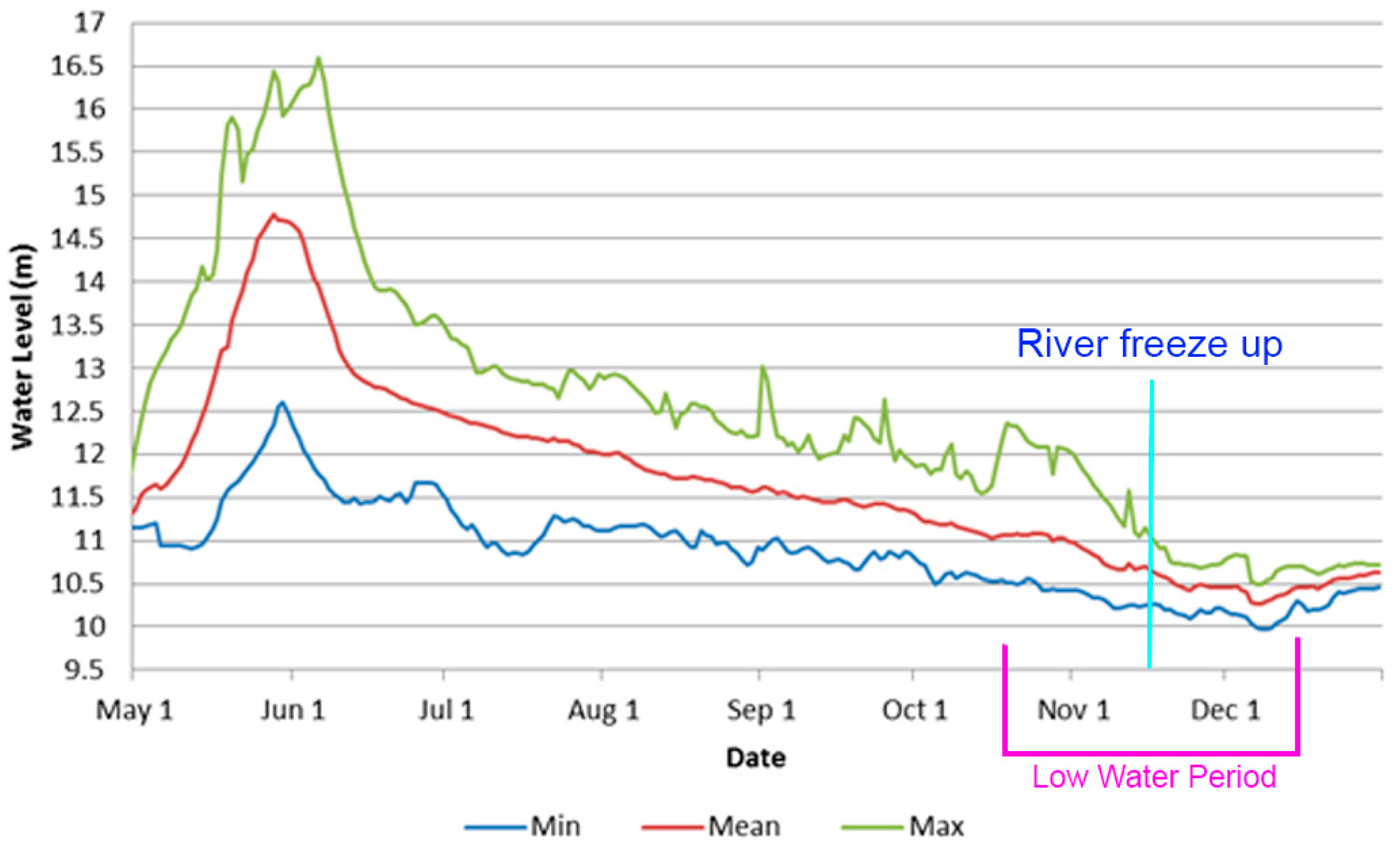
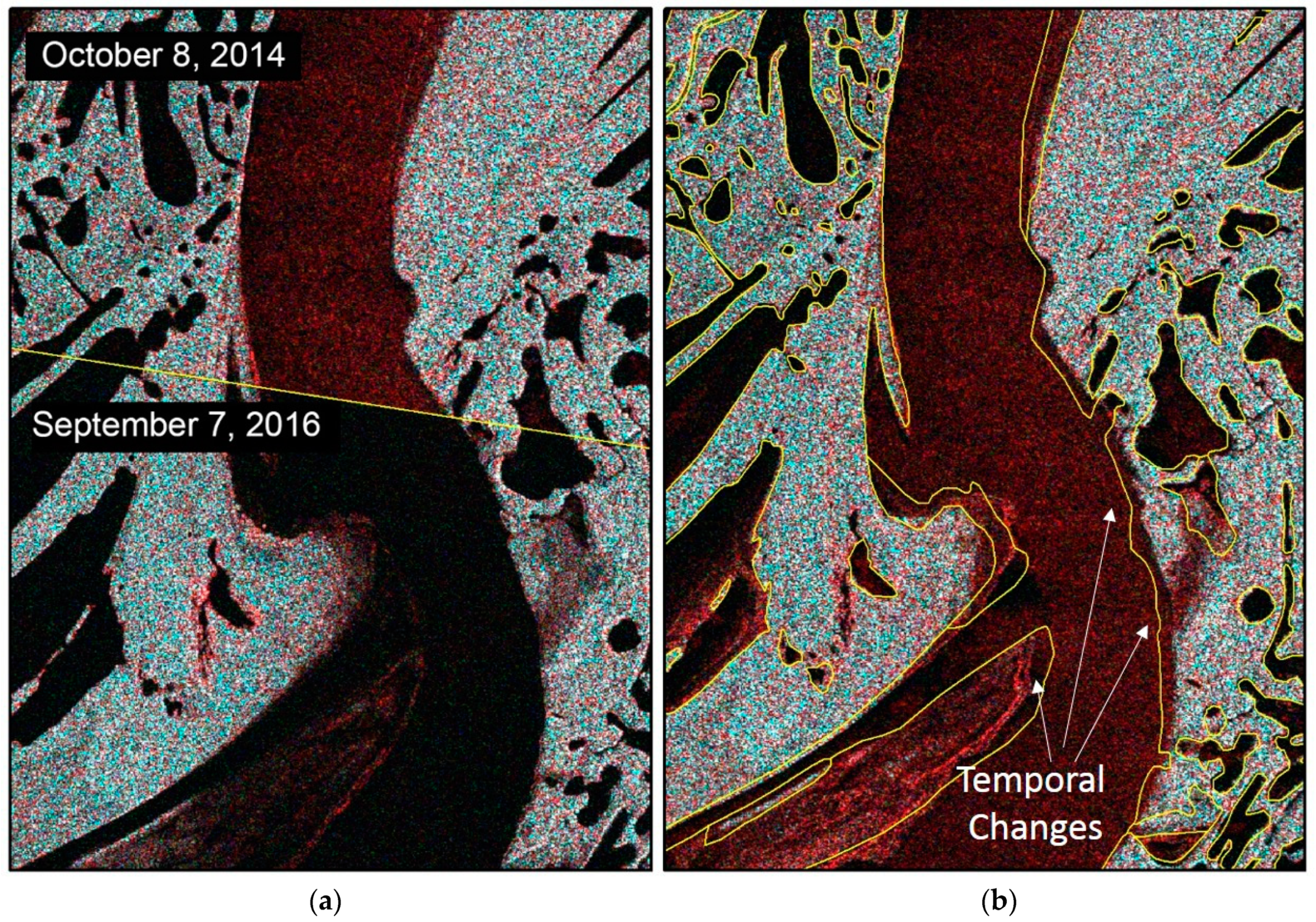
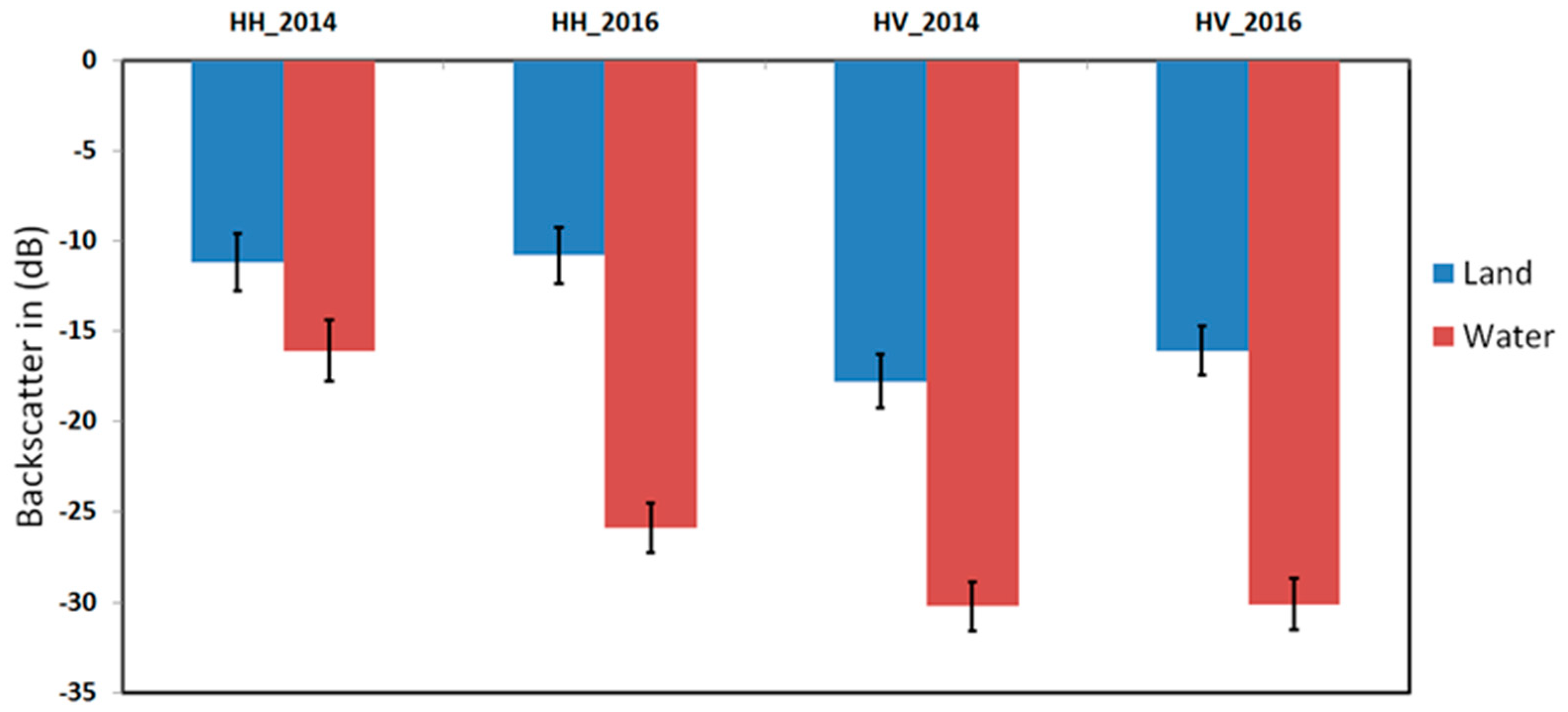
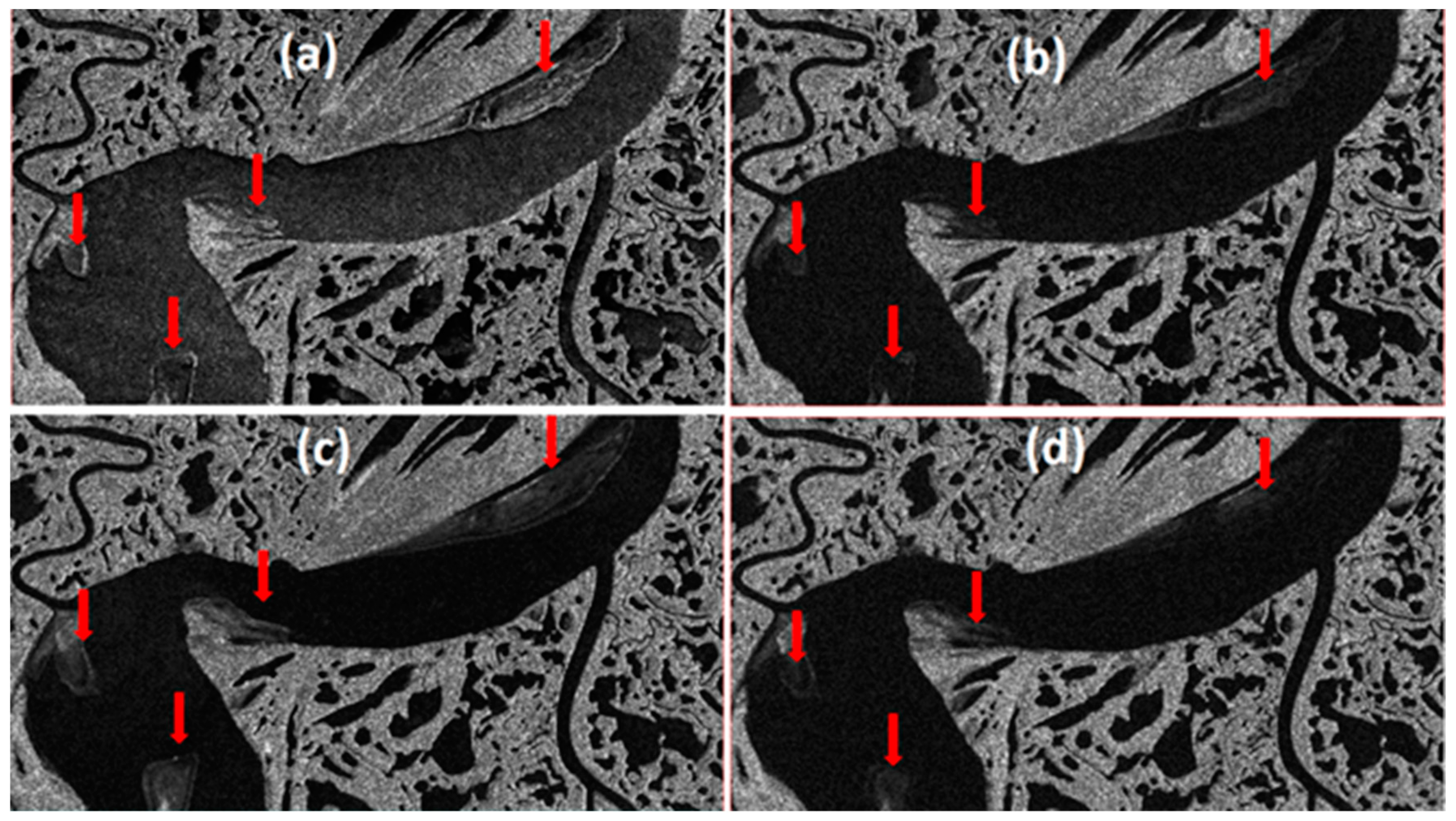

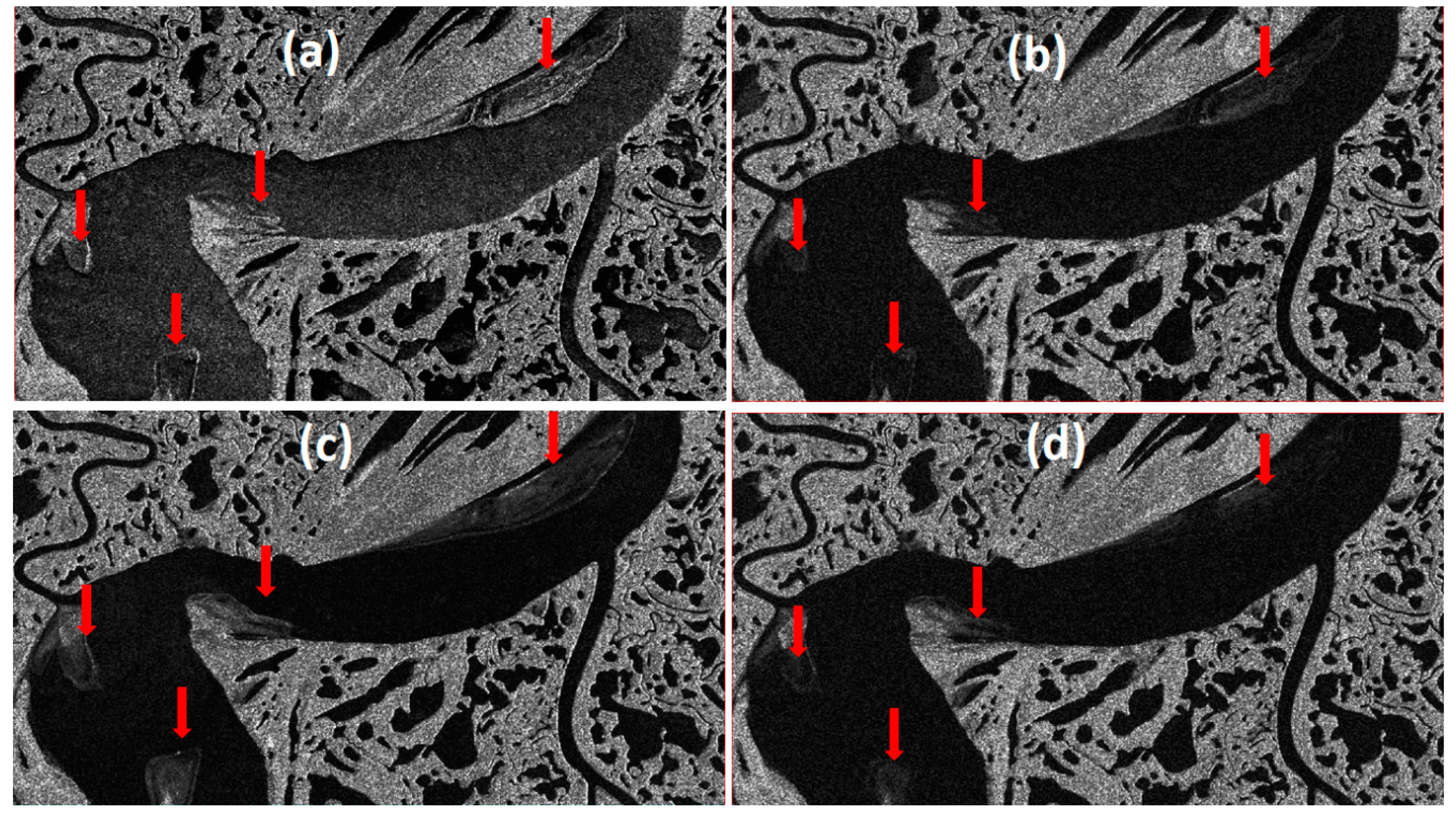
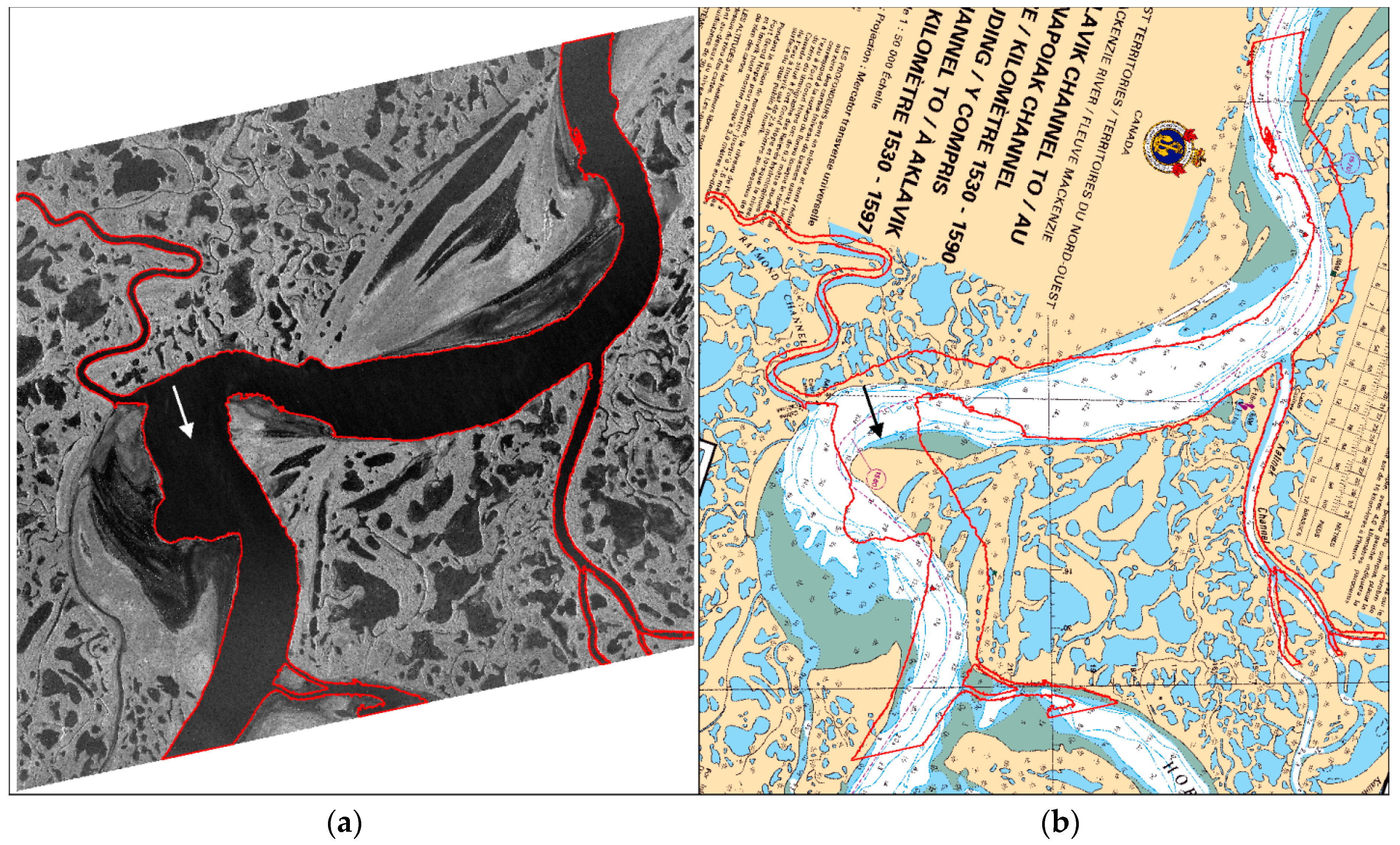

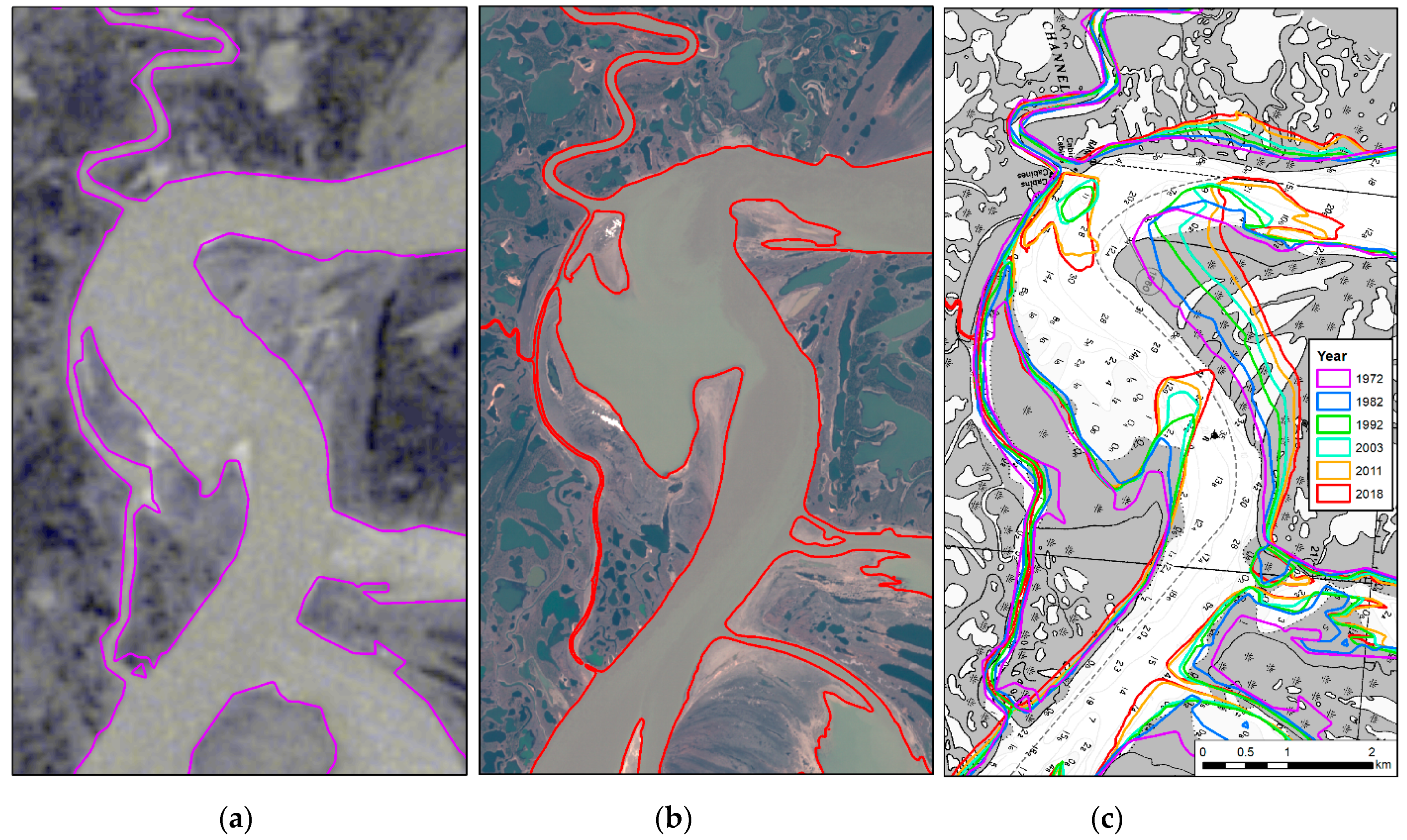
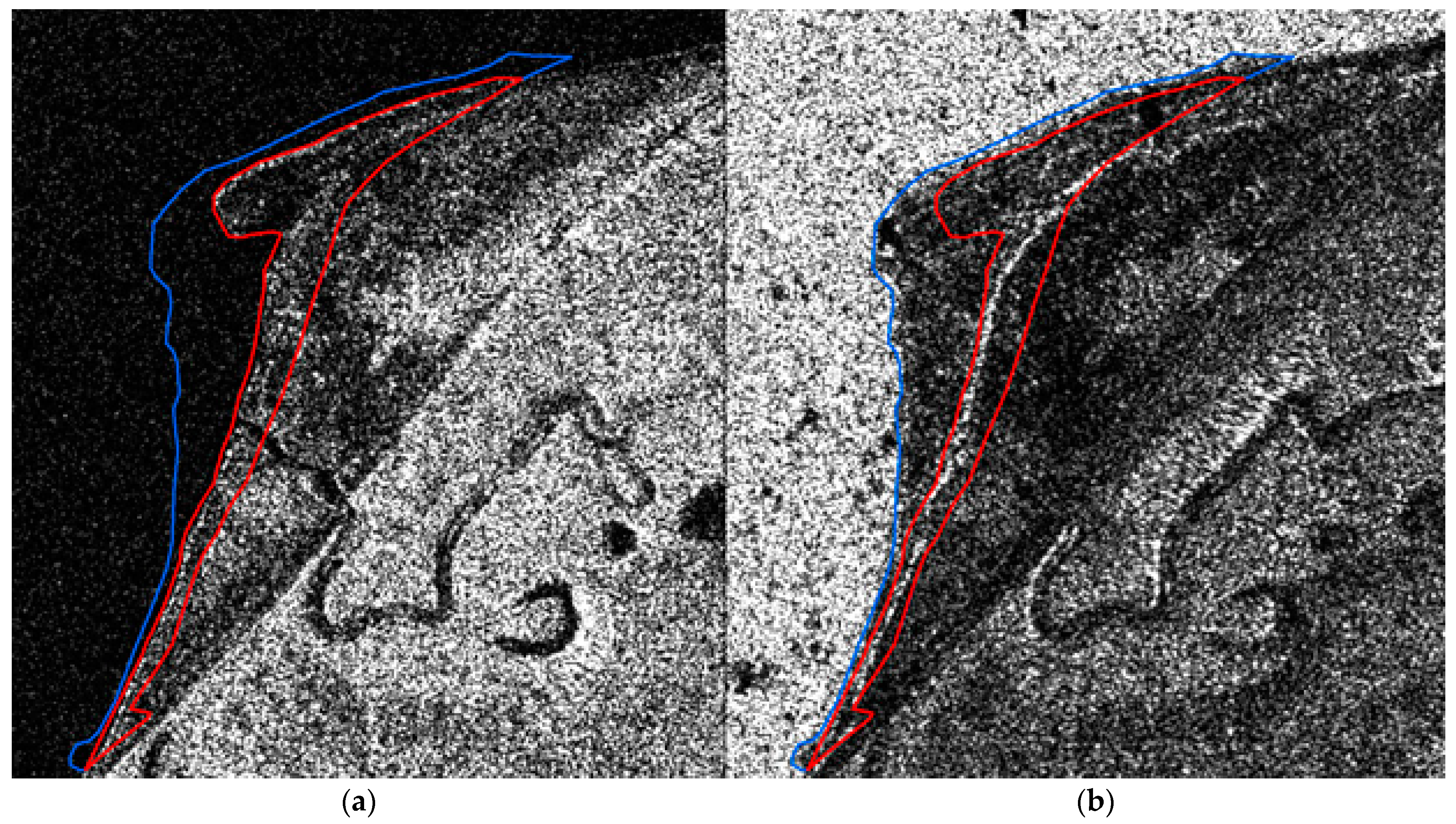
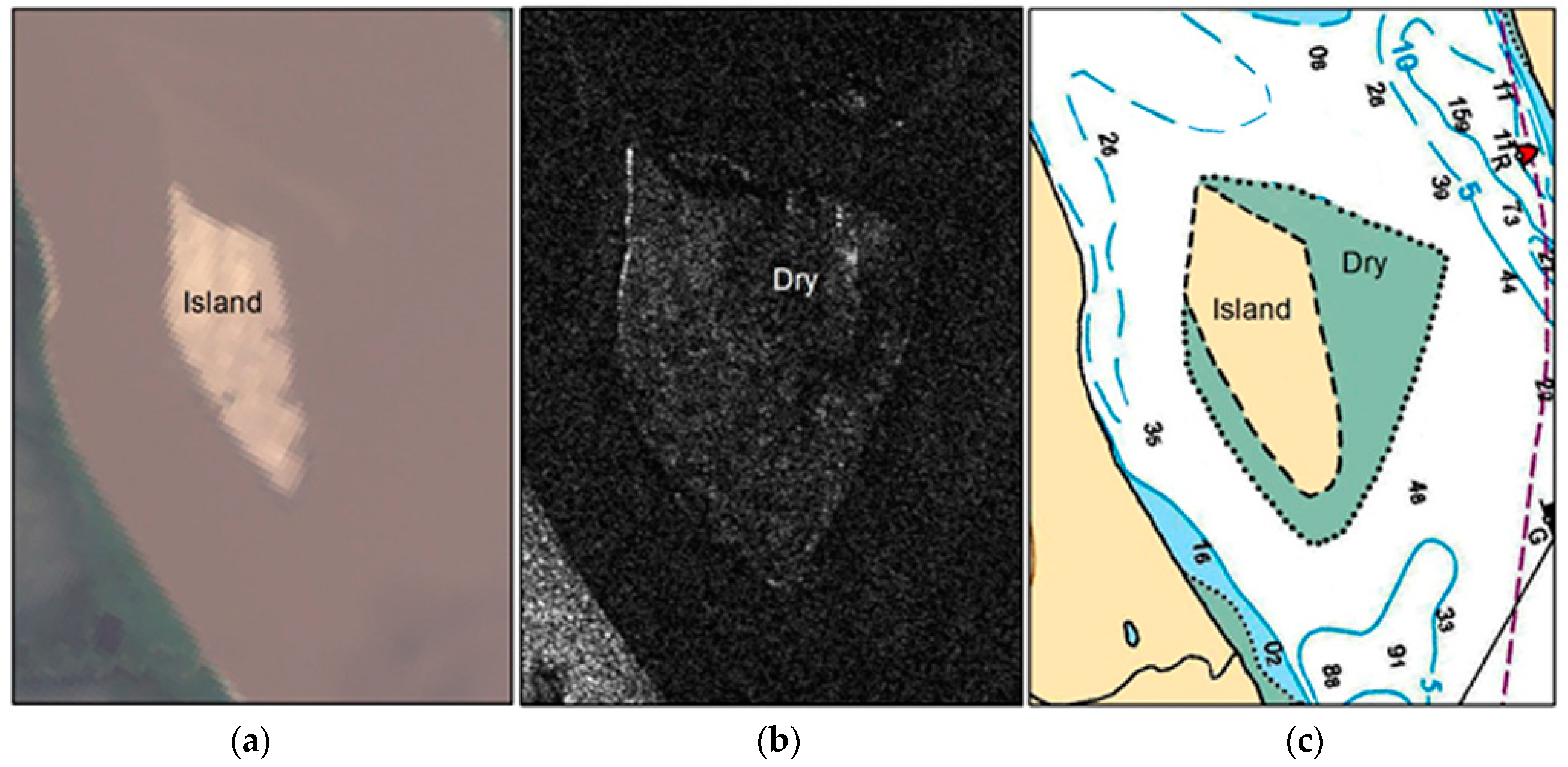

| Acquisition Date | Acquisition Time (UTC) | Beam Mode | Polarization | Water Level (m) |
|---|---|---|---|---|
| October 8, 2014 | 15:39:39 | FQ15 | HH, HV, HV, VV | 12.125 |
| September 7, 2016 | 15:39:45 | FQ 25 | HH, HV, HV, VV | 11.482 |
| October 19, 2015 | 02:31:31 | Spotlight 15 | HH | 11.075 |
| October 9, 2017 | 15:39:45 | Fine 23 | HH, HV | 11.337 |
| Source | Bands | Acquisition Date | Water Level (m) |
|---|---|---|---|
| Landsat-1 | G, R, NIR | September 4, 1972 | N/A |
| Landsat-3 | G, R, NIR | July 14, 1982 | 11.635 |
| Landsat-5 | B, G, R, NIR, SWIR | July 25, 1992 | 12.297 |
| Landsat-5 | B, G, R, NIR, SWIR | August 9, 2003 | 12.224 |
| Landsat-5 | B, G, R, NIR, SWIR | August 31, 2011 | 11.741 |
| Sentinel-2 | B, G, R, NIR | June 13, 2018 | 12.896 |
| Landsat-8 | B, G, R, NIR, SWIR | July 28, 2017 | N/A |
© 2019 by the authors. Licensee MDPI, Basel, Switzerland. This article is an open access article distributed under the terms and conditions of the Creative Commons Attribution (CC BY) license (http://creativecommons.org/licenses/by/4.0/).
Share and Cite
Chénier, R.; Omari, K.; Ahola, R.; Sagram, M. Charting Dynamic Areas in the Mackenzie River with RADARSAT-2, Simulated RADARSAT Constellation Mission and Optical Remote Sensing Data. Remote Sens. 2019, 11, 1523. https://doi.org/10.3390/rs11131523
Chénier R, Omari K, Ahola R, Sagram M. Charting Dynamic Areas in the Mackenzie River with RADARSAT-2, Simulated RADARSAT Constellation Mission and Optical Remote Sensing Data. Remote Sensing. 2019; 11(13):1523. https://doi.org/10.3390/rs11131523
Chicago/Turabian StyleChénier, René, Khalid Omari, Ryan Ahola, and Mesha Sagram. 2019. "Charting Dynamic Areas in the Mackenzie River with RADARSAT-2, Simulated RADARSAT Constellation Mission and Optical Remote Sensing Data" Remote Sensing 11, no. 13: 1523. https://doi.org/10.3390/rs11131523
APA StyleChénier, R., Omari, K., Ahola, R., & Sagram, M. (2019). Charting Dynamic Areas in the Mackenzie River with RADARSAT-2, Simulated RADARSAT Constellation Mission and Optical Remote Sensing Data. Remote Sensing, 11(13), 1523. https://doi.org/10.3390/rs11131523






